TOYOTA COROLLA 2022 Owners Manual (in English)
Manufacturer: TOYOTA, Model Year: 2022, Model line: COROLLA, Model: TOYOTA COROLLA 2022Pages: 678, PDF Size: 147.24 MB
Page 511 of 678

509
8
8-2. Steps to take in an emergency
When trouble arises
One of the following may be the
cause of the problem:
There may not be sufficient fuel
in the vehicle’s tank. Refuel the
vehicle.
The engine may be flooded. Try
to restart the engine again fol-
lowing correct starting proce-
dures. ( P.159, 160)
There may be a malfunction in
the engine immobilizer system.
( P. 7 4 )
One of the following may be the
cause of the problem:
The battery may be discharged.
( P.513)
The battery terminal connec-
NOTICE
■Be careful when driving over
bumps with the compact spare
tire installed on the vehicle.
The vehicle becomes lower when
driving with the compact spare tire
compared to when driving with stand- ard tires. Be careful when driving over
uneven road surfaces.
■Driving with tire chains and the compact spare tire
Do not fit tire chains to the compact
spare tire. Tire chains may damage the vehicle body and adversely affect
driving performance.
■When replacing the tires
When removing or fitting the wheels,
tires or the tire pressure warning valve and transmitter, contact any
authorized Toyota retailer or Toyota
authorized repairer, or any reliable repairer as the tire pressure warning
valve and transmitter may be dam-
aged if not handled correctly.
■To avoid damage to the tire pres-
sure warning valves and trans- mitters
When a tire is repaired with liquid
sealants, the tire pressure warning valve and transmitter may not operate
properly. If a liquid sealant is used,
contact any authorized Toyota retailer or Toyota authorized repairer, or any
reliable repairer or other qualified ser-
vice shop as soon as possible. Make sure to replace the tire pressure warn-
ing valve and transmitter when
replacing the tire. ( P.441)
If the engine will not
star t
If the engine will not start even
though correct starting proce-
dures are being followed
( P.159, 160), consider each of
the following points:
The engine will not start
even though the starter
motor operates normally.
The starter motor turns over
slowly, the interior lights
and headlights are dim, or
the horn does not sound or
sounds at a low volume.
Page 512 of 678
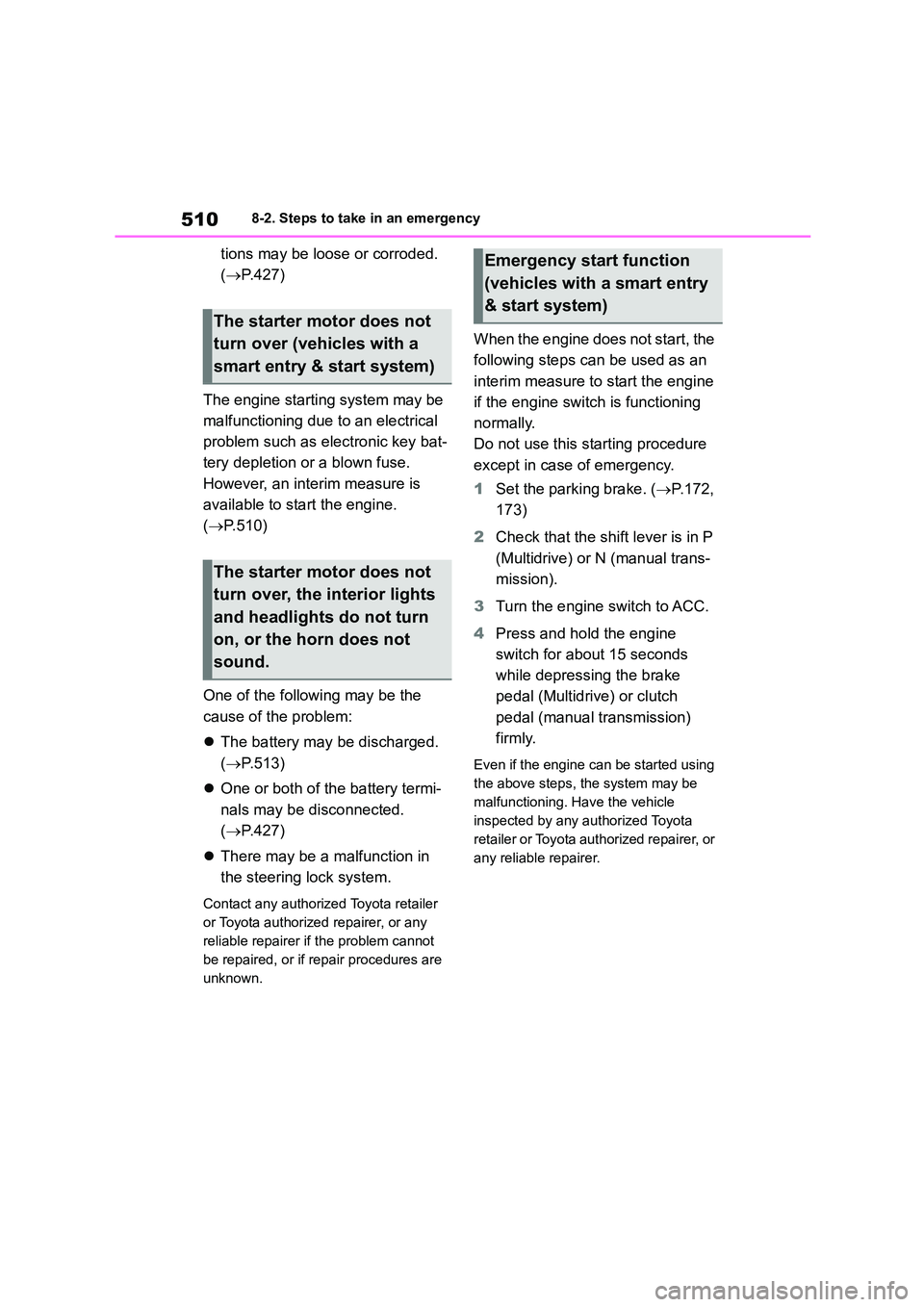
5108-2. Steps to take in an emergency
tions may be loose or corroded.
( P.427)
The engine starting system may be
malfunctioning due to an electrical
problem such as electronic key bat-
tery depletion or a blown fuse.
However, an interim measure is
available to start the engine.
( P.510)
One of the following may be the
cause of the problem:
The battery may be discharged.
( P.513)
One or both of the battery termi-
nals may be disconnected.
( P.427)
There may be a malfunction in
the steering lock system.
Contact any authorized Toyota retailer
or Toyota authorized repairer, or any
reliable repairer if the problem cannot
be repaired, or if repair procedures are
unknown.
When the engine does not start, the
following steps can be used as an
interim measure to start the engine
if the engine switch is functioning
normally.
Do not use this starting procedure
except in case of emergency.
1 Set the parking brake. (P.172,
173)
2 Check that the shift lever is in P
(Multidrive) or N (manual trans-
mission).
3 Turn the engine switch to ACC.
4 Press and hold the engine
switch for about 15 seconds
while depressing the brake
pedal (Multidrive) or clutch
pedal (manual transmission)
firmly.
Even if the engine can be started using
the above steps, the system may be
malfunctioning. Have the vehicle
inspected by any authorized Toyota
retailer or Toyota authorized repairer, or
any reliable repairer.
The starter motor does not
turn over (vehicles with a
smart entry & start system)
The starter motor does not
turn over, the interior lights
and headlights do not turn
on, or the horn does not
sound.
Emergency start function
(vehicles with a smart entry
& start system)
Page 513 of 678
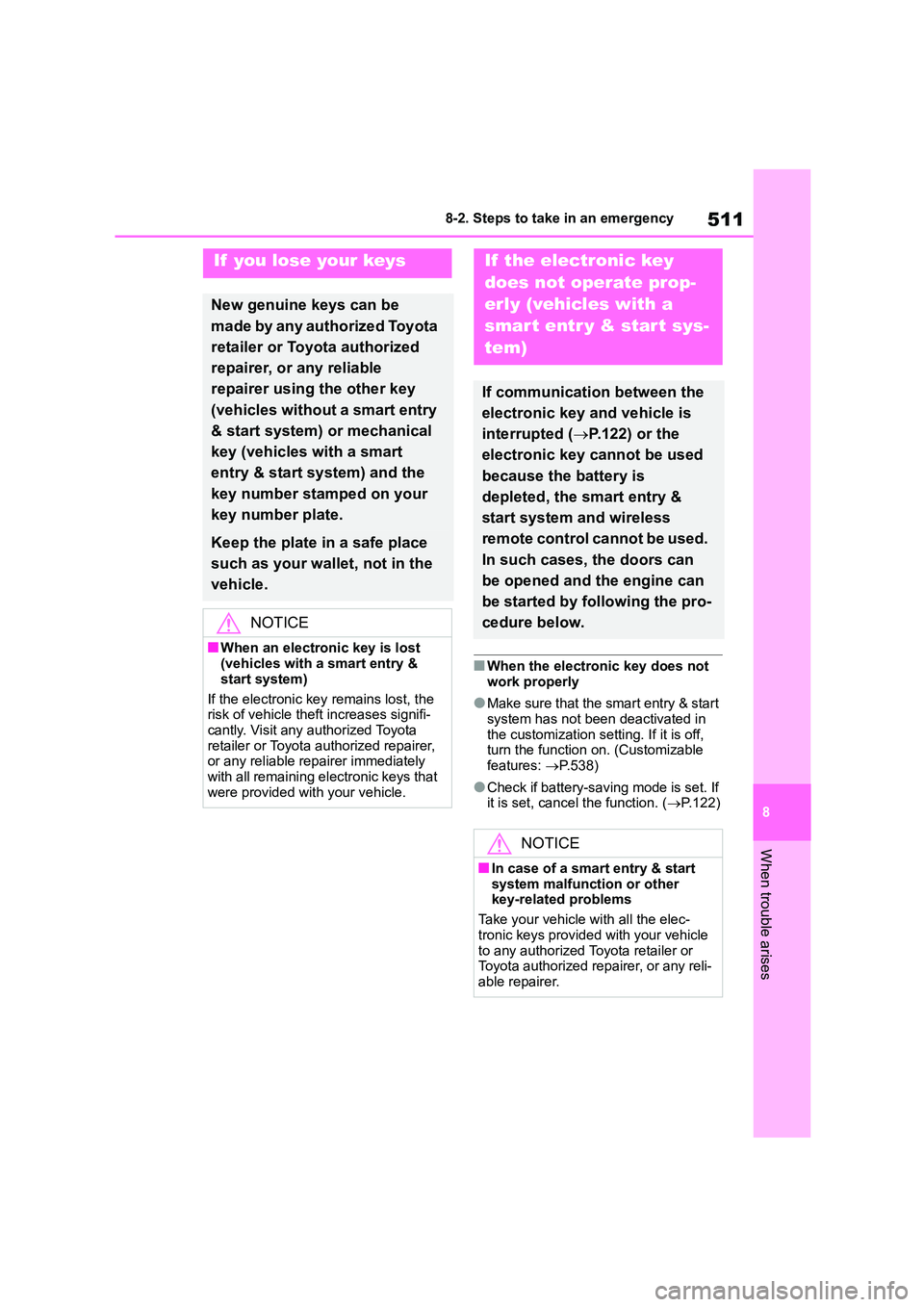
511
8
8-2. Steps to take in an emergency
When trouble arises
■When the electronic key does not
work properly
●Make sure that the smart entry & start
system has not been deactivated in
the customization setting. If it is off, turn the function on. (Customizable
features: P.538)
●Check if battery-saving mode is set. If it is set, cancel the function. ( P.122)
If you lose your keys
New genuine keys can be
made by any authorized Toyota
retailer or Toyota authorized
repairer, or any reliable
repairer using the other key
(vehicles without a smart entry
& start system) or mechanical
key (vehicles with a smart
entry & start system) and the
key number stamped on your
key number plate.
Keep the plate in a safe place
such as your wallet, not in the
vehicle.
NOTICE
■When an electronic key is lost
(vehicles with a smart entry &
start system)
If the electronic ke y remains lost, the
risk of vehicle thef t increases signifi-
cantly. Visit any authorized Toyota retailer or Toyota authorized repairer,
or any reliable repairer immediately
with all remaining electronic keys that were provided with your vehicle.
If the electronic key
does not operate prop-
erly (vehicles with a
smar t entr y & star t sys-
tem)
If communication between the
electronic key and vehicle is
interrupted ( P.122) or the
electronic key cannot be used
because the battery is
depleted, the smart entry &
start system and wireless
remote control cannot be used.
In such cases, the doors can
be opened and the engine can
be started by following the pro-
cedure below.
NOTICE
■In case of a smart entry & start
system malfunction or other key-related problems
Take your vehicle with all the elec-
tronic keys provided with your vehicle to any authorized Toyota retailer or
Toyota authorized repairer, or any reli-
able repairer.
Page 514 of 678
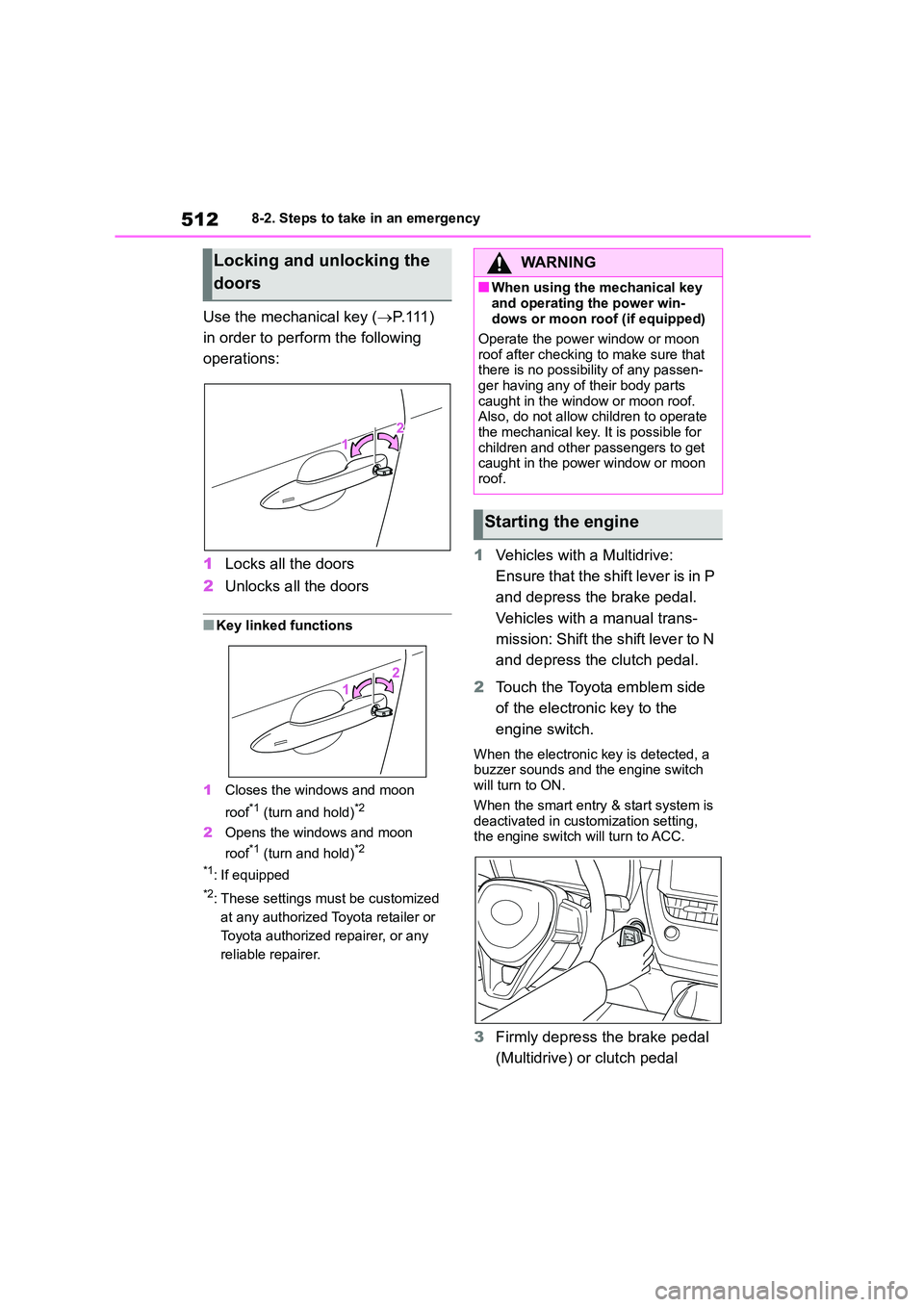
5128-2. Steps to take in an emergency
Use the mechanical key (P. 111 )
in order to perform the following
operations:
1 Locks all the doors
2 Unlocks all the doors
■Key linked functions
1 Closes the windows and moon
roof*1 (turn and hold)*2
2 Opens the windows and moon
roof*1 (turn and hold)*2
*1: If equipped
*2: These settings must be customized
at any authorized Toyota retailer or
Toyota authorized repairer, or any
reliable repairer.
1 Vehicles with a Multidrive:
Ensure that the shift lever is in P
and depress the brake pedal.
Vehicles with a manual trans-
mission: Shift the shift lever to N
and depress the clutch pedal.
2 Touch the Toyota emblem side
of the electronic key to the
engine switch.
When the electronic key is detected, a
buzzer sounds and the engine switch will turn to ON.
When the smart entry & start system is
deactivated in customization setting, the engine switch will turn to ACC.
3 Firmly depress the brake pedal
(Multidrive) or clutch pedal
Locking and unlocking the
doors
WA R N I N G
■When using the mechanical key
and operating the power win-
dows or moon roof (if equipped)
Operate the power window or moon
roof after checking to make sure that
there is no possibility of any passen- ger having any of their body parts
caught in the window or moon roof.
Also, do not allow children to operate
the mechanical key. It is possible for children and other passengers to get
caught in the power window or moon
roof.
Starting the engine
Page 515 of 678
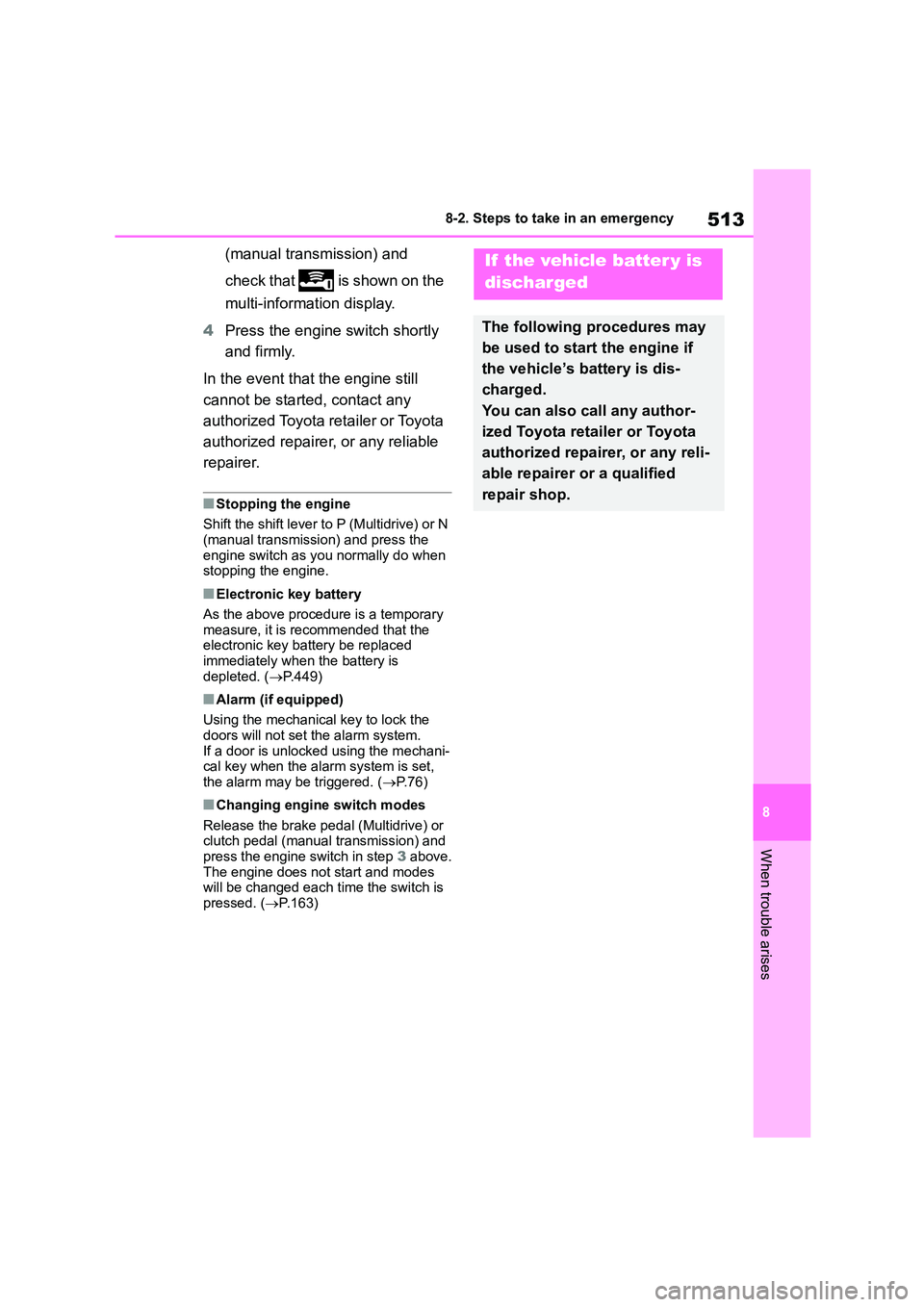
513
8
8-2. Steps to take in an emergency
When trouble arises
(manual transmission) and
check that is shown on the
multi-information display.
4 Press the engine switch shortly
and firmly.
In the event that the engine still
cannot be started, contact any
authorized Toyota retailer or Toyota
authorized repairer, or any reliable
repairer.
■Stopping the engine
Shift the shift lever to P (Multidrive) or N
(manual transmission) and press the
engine switch as you normally do when stopping the engine.
■Electronic key battery
As the above procedure is a temporary
measure, it is recommended that the electronic key battery be replaced
immediately when the battery is
depleted. ( P.449)
■Alarm (if equipped)
Using the mechanical key to lock the
doors will not set the alarm system.
If a door is unlocked using the mechani-
cal key when the alarm system is set, the alarm may be triggered. ( P.76)
■Changing engine switch modes
Release the brake pedal (Multidrive) or
clutch pedal (manual transmission) and press the engine switch in step 3 above.
The engine does not start and modes
will be changed each time the switch is pressed. ( P.163)
If the vehicle batter y is
discharged
The following procedures may
be used to start the engine if
the vehicle’s battery is dis-
charged.
You can also call any author-
ized Toyota retailer or Toyota
authorized repairer, or any reli-
able repairer or a qualified
repair shop.
Page 516 of 678
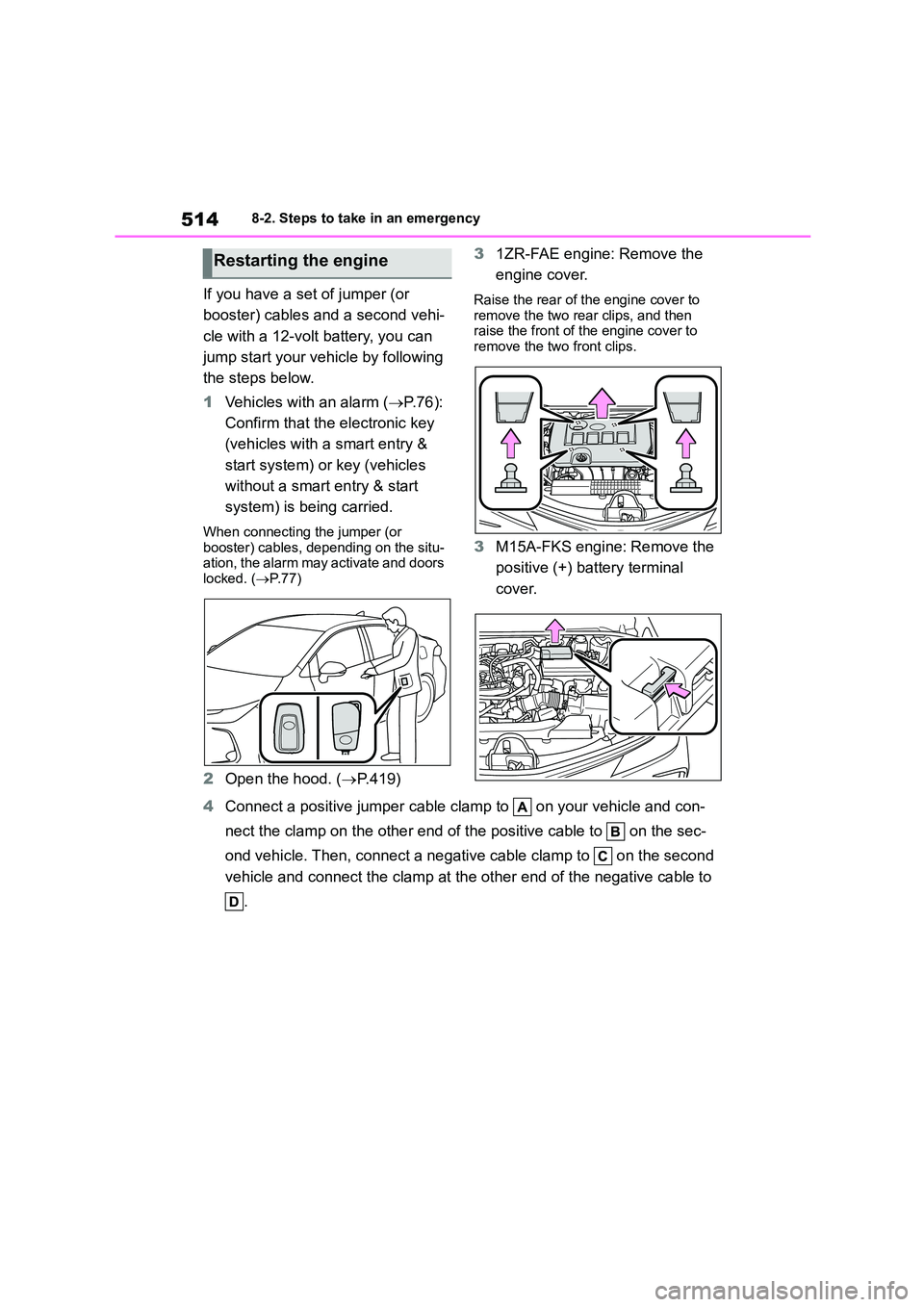
5148-2. Steps to take in an emergency
If you have a set of jumper (or
booster) cables and a second vehi-
cle with a 12-volt battery, you can
jump start your vehicle by following
the steps below.
1 Vehicles with an alarm (P. 7 6 ) :
Confirm that the electronic key
(vehicles with a smart entry &
start system) or key (vehicles
without a smart entry & start
system) is being carried.
When connecting the jumper (or booster) cables, depending on the situ-
ation, the alarm may activate and doors
locked. ( P.77)
2Open the hood. (P.419)
3 1ZR-FAE engine: Remove the
engine cover.
Raise the rear of the engine cover to
remove the two rear clips, and then raise the front of the engine cover to
remove the two front clips.
3 M15A-FKS engine: Remove the
positive (+) battery terminal
cover.
4 Connect a positive jumper cable clamp to on your vehicle and con-
nect the clamp on the other end of the positive cable to on the sec-
ond vehicle. Then, connect a negativ e cable clamp to on the second
vehicle and connect the clamp at the other end of the negative cable to
.
Restarting the engine
Page 517 of 678
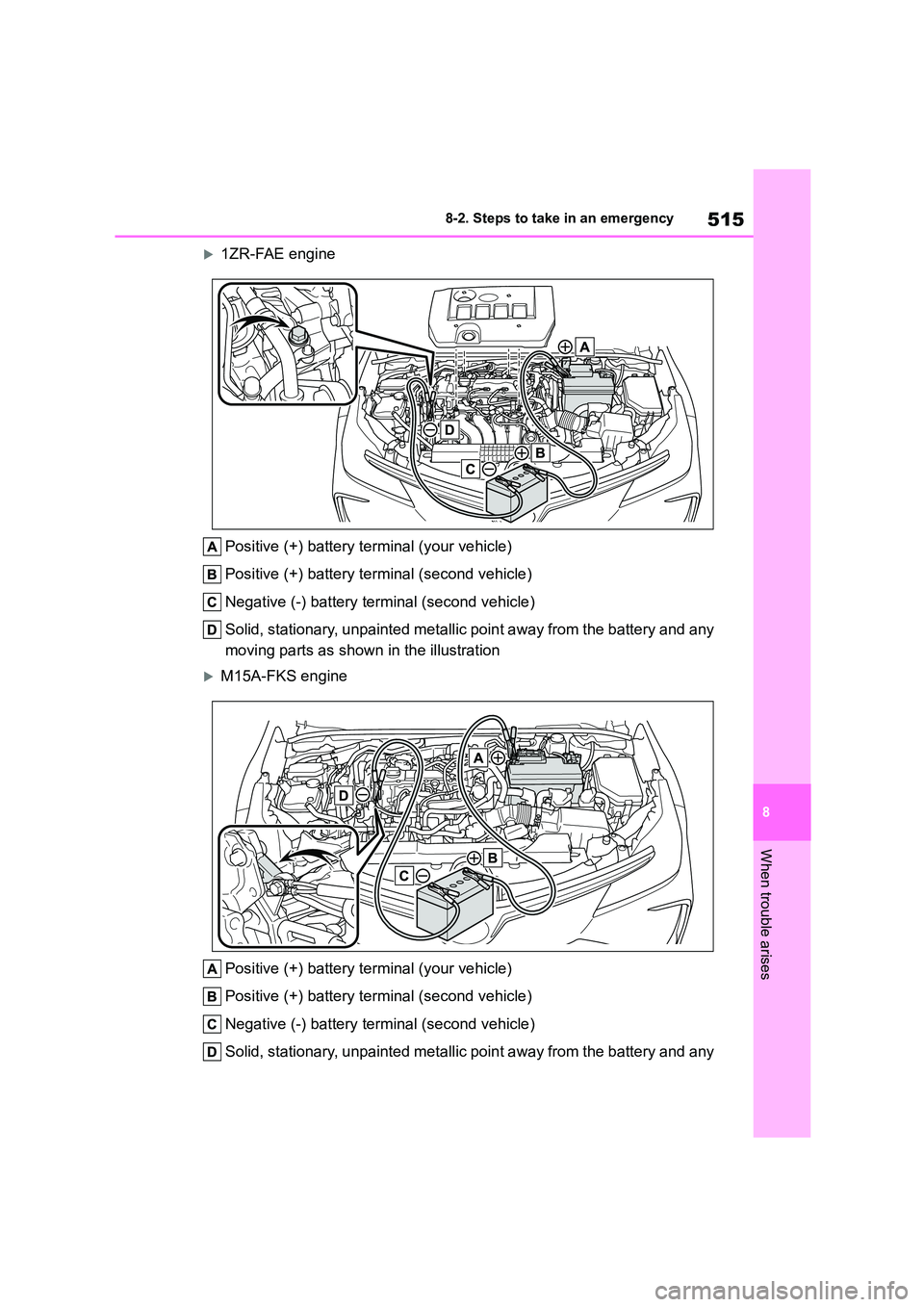
515
8
8-2. Steps to take in an emergency
When trouble arises
1ZR-FAE engine
Positive (+) battery terminal (your vehicle)
Positive (+) battery terminal (second vehicle)
Negative (-) battery terminal (second vehicle)
Solid, stationary, unpainted metallic po int away from the battery and any
moving parts as shown in the illustration
M15A-FKS engine
Positive (+) battery terminal (your vehicle)
Positive (+) battery terminal (second vehicle)
Negative (-) battery terminal (second vehicle)
Solid, stationary, unpainted metallic po int away from the battery and any
Page 518 of 678
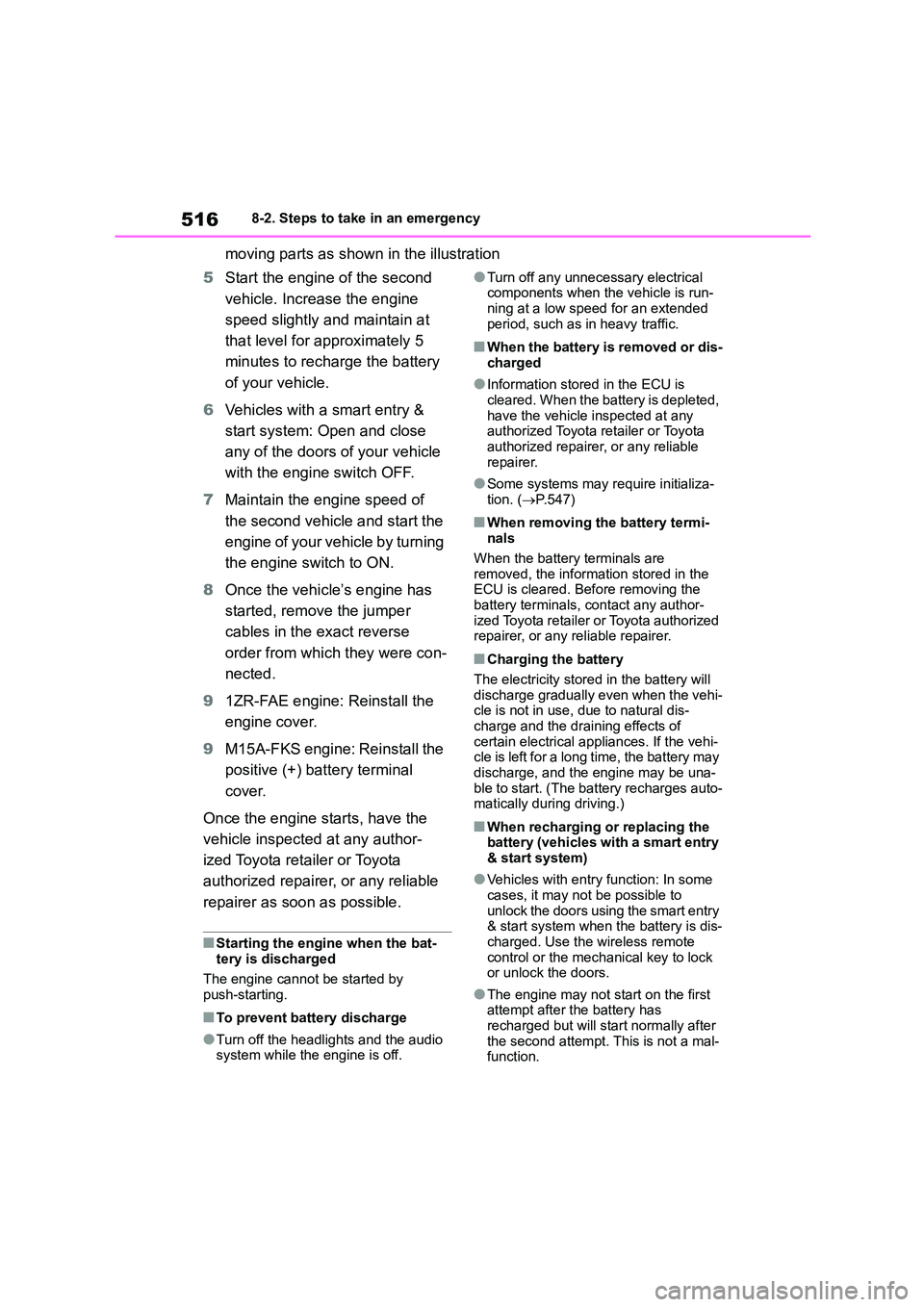
5168-2. Steps to take in an emergency
moving parts as shown in the illustration
5 Start the engine of the second
vehicle. Increase the engine
speed slightly and maintain at
that level for approximately 5
minutes to recharge the battery
of your vehicle.
6 Vehicles with a smart entry &
start system: Open and close
any of the doors of your vehicle
with the engine switch OFF.
7 Maintain the engine speed of
the second vehicle and start the
engine of your vehicle by turning
the engine switch to ON.
8 Once the vehicle’s engine has
started, remove the jumper
cables in the exact reverse
order from which they were con-
nected.
9 1ZR-FAE engine: Reinstall the
engine cover.
9 M15A-FKS engine: Reinstall the
positive (+) battery terminal
cover.
Once the engine starts, have the
vehicle inspected at any author-
ized Toyota reta iler or Toyota
authorized repairer, or any reliable
repairer as soon as possible.
■Starting the engine when the bat- tery is discharged
The engine cannot be started by
push-starting.
■To prevent battery discharge
●Turn off the headlights and the audio
system while the engine is off.
●Turn off any unnecessary electrical
components when the vehicle is run-
ning at a low speed for an extended period, such as in heavy traffic.
■When the battery is removed or dis-
charged
●Information stored in the ECU is
cleared. When the battery is depleted,
have the vehicle inspected at any authorized Toyota retailer or Toyota
authorized repairer, or any reliable
repairer.
●Some systems may require initializa-
tion. ( P.547)
■When removing the battery termi- nals
When the battery terminals are
removed, the information stored in the ECU is cleared. Before removing the
battery terminals, contact any author-
ized Toyota retailer or Toyota authorized repairer, or any reliable repairer.
■Charging the battery
The electricity stored in the battery will
discharge gradually even when the vehi- cle is not in use, due to natural dis-
charge and the draining effects of
certain electrical appliances. If the vehi- cle is left for a long time, the battery may
discharge, and the engine may be una-
ble to start. (The battery recharges auto- matically during driving.)
■When recharging or replacing the
battery (vehicles with a smart entry
& start system)
●Vehicles with entry function: In some
cases, it may not be possible to unlock the doors using the smart entry
& start system when the battery is dis-
charged. Use the wireless remote
control or the mechanical key to lock or unlock the doors.
●The engine may not start on the first attempt after the battery has
recharged but will start normally after
the second attempt. This is not a mal- function.
Page 519 of 678
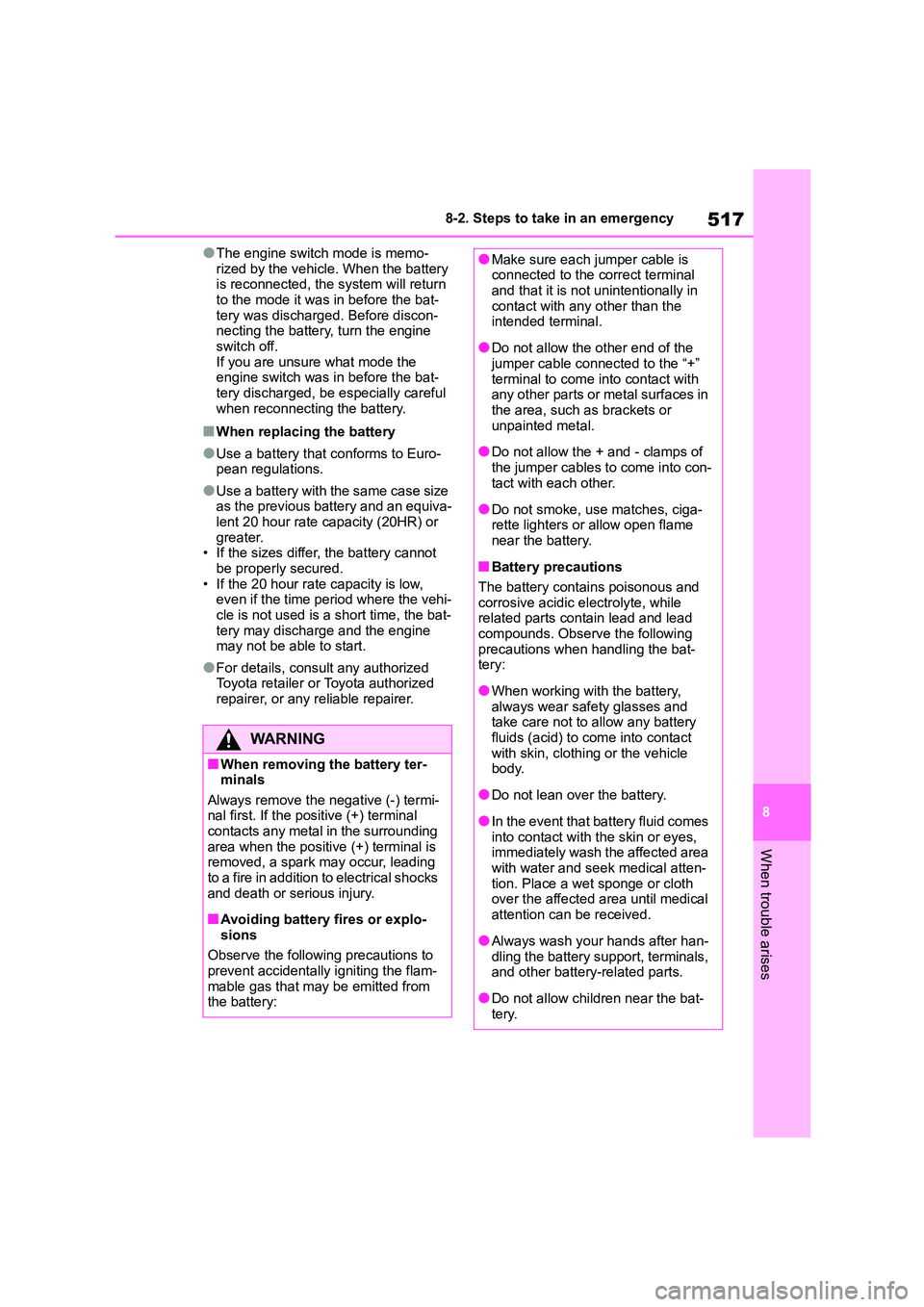
517
8
8-2. Steps to take in an emergency
When trouble arises
●The engine switch mode is memo-
rized by the vehicle. When the battery is reconnected, the system will return
to the mode it was in before the bat-
tery was discharged. Before discon- necting the battery, turn the engine
switch off.
If you are unsure what mode the engine switch was in before the bat-
tery discharged, be especially careful
when reconnecting the battery.
■When replacing the battery
●Use a battery that conforms to Euro-
pean regulations.
●Use a battery with the same case size
as the previous battery and an equiva- lent 20 hour rate capacity (20HR) or
greater.
• If the sizes differ, the battery cannot be properly secured.
• If the 20 hour rate capacity is low,
even if the time period where the vehi- cle is not used is a short time, the bat-
tery may discharge and the engine
may not be able to start.
●For details, consult any authorized
Toyota retailer or Toyota authorized repairer, or any reliable repairer.
WA R N I N G
■When removing the battery ter-
minals
Always remove the negative (-) termi- nal first. If the positive (+) terminal
contacts any metal in the surrounding
area when the positive (+) terminal is removed, a spark may occur, leading
to a fire in addition to electrical shocks
and death or serious injury.
■Avoiding battery fires or explo-
sions
Observe the following precautions to
prevent accidentally igniting the flam-
mable gas that may be emitted from the battery:
●Make sure each jumper cable is connected to the correct terminal
and that it is not unintentionally in
contact with any other than the intended terminal.
●Do not allow the other end of the jumper cable connected to the “+”
terminal to come into contact with
any other parts or metal surfaces in the area, such as brackets or
unpainted metal.
●Do not allow the + and - clamps of
the jumper cables to come into con-
tact with each other.
●Do not smoke, use matches, ciga-
rette lighters or allow open flame near the battery.
■Battery precautions
The battery contains poisonous and
corrosive acidic electrolyte, while
related parts contain lead and lead compounds. Observe the following
precautions when handling the bat-
tery:
●When working with the battery,
always wear safety glasses and take care not to allow any battery
fluids (acid) to come into contact
with skin, clothing or the vehicle body.
●Do not lean over the battery.
●In the event that battery fluid comes
into contact with the skin or eyes, immediately wash the affected area
with water and seek medical atten-
tion. Place a wet sponge or cloth over the affected area until medical
attention can be received.
●Always wash your hands after han- dling the battery support, terminals,
and other battery-related parts.
●Do not allow children near the bat-
tery.
Page 520 of 678
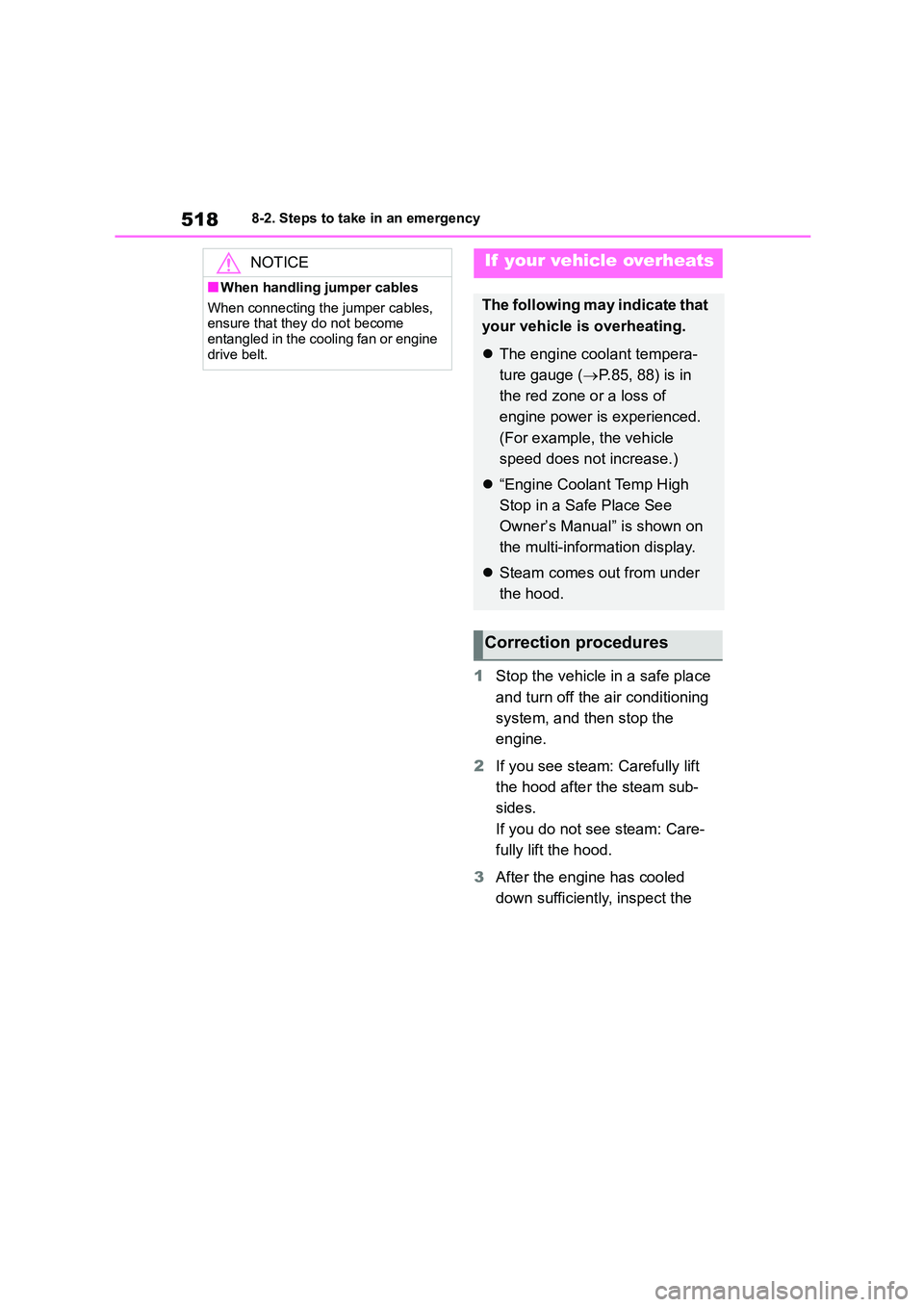
5188-2. Steps to take in an emergency
1Stop the vehicle in a safe place
and turn off the air conditioning
system, and then stop the
engine.
2 If you see steam: Carefully lift
the hood after the steam sub-
sides.
If you do not see steam: Care-
fully lift the hood.
3 After the engine has cooled
down sufficiently, inspect the
NOTICE
■When handling jumper cables
When connecting the jumper cables,
ensure that they do not become entangled in the cooling fan or engine
drive belt.
If your vehicle overheats
The following may indicate that
your vehicle is overheating.
The engine coolant tempera-
ture gauge ( P.85, 88) is in
the red zone or a loss of
engine power is experienced.
(For example, the vehicle
speed does not increase.)
“Engine Coolant Temp High
Stop in a Safe Place See
Owner’s Manual” is shown on
the multi-information display.
Steam comes out from under
the hood.
Correction procedures